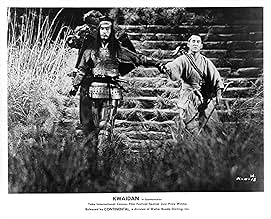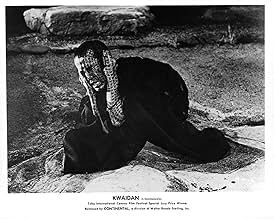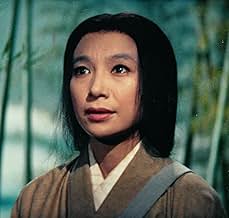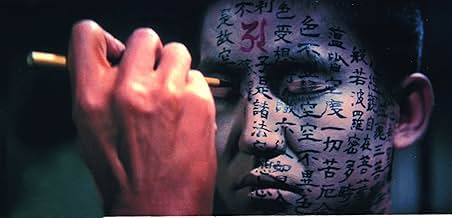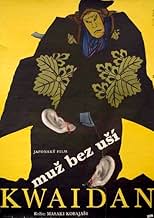VALUTAZIONE IMDb
7,9/10
21.744
LA TUA VALUTAZIONE
Una raccolta di quattro racconti popolari giapponesi con temi soprannaturali.Una raccolta di quattro racconti popolari giapponesi con temi soprannaturali.Una raccolta di quattro racconti popolari giapponesi con temi soprannaturali.
- Regia
- Sceneggiatura
- Star
- Candidato a 1 Oscar
- 5 vittorie e 3 candidature totali
Recensioni in evidenza
'Kwaidan' is an astonishing film, once seen never forgotten. It's labeled horror, but while the four stories within deal with ghosts and the supernatural, I doubt that anyone would be actually frightened watching it. Haunted, yes, scared, no. It's a beautiful movie, very stylized with a very imaginative use of colour. I can't think of anything else I've seen that comes close. Mario Bava, maybe. The movie consists of four stories. I think it's best watched as a whole to let each story blend in to the other, but if forced to choose I would say my favourite segment is the second one ('The Woman In The Snow') which I believe was left out of the version of the movie originally shown outside Japan. 'Kwaidan' is one of those rare movies that leaves you stunned the first time you see it. For me it's equal to 'Rashomon', 'Woman In The Dunes' and 'Branded To Kill' as the most amazing Japanese movies I've ever seen. Each one of these movies blew my mind. It's difficult not to gush about all four. They come with my highest recommendation. I sincerely believe that anybody who watches them will be incredibly impressed. They are all masterpieces.
Kwaidan is a four-segment horror anthology but you'd be hard pressed to find one more removed from the typical plastic bats and cobwebs Gothic anthologies of Amicus or Hammer. While it can be billed as a "horror" movie and it deals with the supernatural, it's not really frightening. All four segments are more like traditional Japanese folk legends about ghosts, the kind of spooky stories you could hear an elder narrating to kids around a bonfire in a village near Kyoto or the outskirts of Okinawa. However if "work of art" was a genre, Kwaidan would be among the best it had to offer.
Just two years after the seminal Seppuku which was done in stark black and white with a geometric, well disciplined style, Kobayashi returns with another tour-de-force, this time in extravagant, expressionistic colour. A visual feast proving that in the right hands style can be substance. His camera with its slow tracking shots is like a brush, painting a celluloid canvas with vivid, lush compositions and it comes as no surprise to find out that he had a background in painting. The combination of eerie, supernatural material, the dreamlike atmosphere and the use of colour in lighting and sets reminded me of the great Italian maestro, Mario Bava; although Kwaidan by no means fits in the Gothic horror mold.
Conscious of the folk legend material he's working on, Kobaysi wisely shot the movie in studio sets using large painted backgrounds that look deliberately artificial as much as they look gorgeous. In many ways, it feels like a big stageplay or an elaborate dramatic poem. In that aspect, Kwaidan takes place somewhere between the real and the mythic. A land of some other order.
The stories all revolve around ghosts and are as simple and predictable as any spooky story that you might hear as an adult. But they do a great job of providing an eerie skeleton for Kobayashi to hang on his beautiful style. Style over substance one could argue. Isn't that an erroneous statement though? By making the distinction one implies that style is somehow insubstantial to a film, something that couldn't be further from the truth. The use of colour is incredible, the lighting, at times subtle and evocative or wild and expressionistic, the slow tracking shots, long stretches of silence, a body painted with holy text, Tatsuya Nakadai looking calm and happy for a change, Tetsuro Tamba in full plate samurai armor, white ghastly faces, bodies falling in blood-red waters, a painted sunset backdrop, an intelligent play on vague endings, the minimal score, chords echoing from somewhere. Kwaidan proves that style IS substance. A visual feast by all means.
It's really a shame that Kobayashi is not as widely celebrated as Akira Kurosawa. Kwaidan is just another in a series of absolutely brilliant films he did in the 60's. Beautiful, creepy, poetic, atmospheric as hell; it is the work of a master cinematician and one of the best Japanese movies you're likely to see.
Just two years after the seminal Seppuku which was done in stark black and white with a geometric, well disciplined style, Kobayashi returns with another tour-de-force, this time in extravagant, expressionistic colour. A visual feast proving that in the right hands style can be substance. His camera with its slow tracking shots is like a brush, painting a celluloid canvas with vivid, lush compositions and it comes as no surprise to find out that he had a background in painting. The combination of eerie, supernatural material, the dreamlike atmosphere and the use of colour in lighting and sets reminded me of the great Italian maestro, Mario Bava; although Kwaidan by no means fits in the Gothic horror mold.
Conscious of the folk legend material he's working on, Kobaysi wisely shot the movie in studio sets using large painted backgrounds that look deliberately artificial as much as they look gorgeous. In many ways, it feels like a big stageplay or an elaborate dramatic poem. In that aspect, Kwaidan takes place somewhere between the real and the mythic. A land of some other order.
The stories all revolve around ghosts and are as simple and predictable as any spooky story that you might hear as an adult. But they do a great job of providing an eerie skeleton for Kobayashi to hang on his beautiful style. Style over substance one could argue. Isn't that an erroneous statement though? By making the distinction one implies that style is somehow insubstantial to a film, something that couldn't be further from the truth. The use of colour is incredible, the lighting, at times subtle and evocative or wild and expressionistic, the slow tracking shots, long stretches of silence, a body painted with holy text, Tatsuya Nakadai looking calm and happy for a change, Tetsuro Tamba in full plate samurai armor, white ghastly faces, bodies falling in blood-red waters, a painted sunset backdrop, an intelligent play on vague endings, the minimal score, chords echoing from somewhere. Kwaidan proves that style IS substance. A visual feast by all means.
It's really a shame that Kobayashi is not as widely celebrated as Akira Kurosawa. Kwaidan is just another in a series of absolutely brilliant films he did in the 60's. Beautiful, creepy, poetic, atmospheric as hell; it is the work of a master cinematician and one of the best Japanese movies you're likely to see.
The words "beautiful", "lyrical" and "evocative" aren't ones that you would normally attribute to a horror movie, but they are precisely the ones that best describe Kwaidan, a quintet of Samurai Gothics based (interestingly enough) on the writings of an American author by the name of Lafcadio Hearn. Shot in gorgeous, sumptuous color way back in 1964 by director Masaki Kobayashi, Kwaidan is an unusual, unique and quite extraordinary entry in the old horror anthology genre best represented by 1945's Dead of Night and Milton Subotsky's Amicus anthology series (i.e. Dr. Terror's House of Horrors, Tales From the Crypt & Asylum).
Kwaidan differentiates itself from the pack in a number of significant ways. To begin with, all of the episodes eschew the usual O. Henry "twist" endings and deliberately telegraph their punches, case in point being "Hoichi the Earless", which gives away its climax with its very title! This film is also missing the compulsory "wrap-around" story normally employed by anthology films to tie all the stories together, and the horror elements are far more low-key than most horror aficianados are used to. Kwaidan is far less concerned with springing shocks and fraying nerves than it is in exploring the whirlwind of conflicting emotions that swirl in the dark night of the human soul.
"The Black Hair" is the tale of an impoverished samurai who abandons his loyal and loving wife to marry the daughter of a wealthy lord in another province, only to discover many years later that he is still in love with his first spouse. He returns to their decaying old house to find her exactly as he left her, affectionate and forgiving as could be. You know something in this household just ain't right. "The Woman in the Snow" concerns an apprentice woodcutter who encounters an eerily beautiful female ice-vampire - called a "Yuki-Onna - who spares his life on the condition that he never tell a soul about their encounter. (If you saw the last episode of the flaccid Tales From the Darkside movie, on which this was based, you have an idea of how this one ends).
"Hoichi the Earless", easily the most powerful of the bunch, regards a blind biwa (a stringed instrument resembling a guitar) player renowned for his moving rendition of the tragic tale of the battle between the Genji and Heiki clans. Each night he is summoned to the nearby graveyard to chant the epic tale for the ghosts of the warriors who fell in that battle, duped by the spirits into believing that he's performing in the home of a wealthy lord. When Hoichi disocvers that he has been decieved by the dead and refuses to perform for them again, the ghosts exact a terrible revenge.
A note of warning to those deterred by long foreign films: this shimmering jewel in Japanese cinema's crown clocks in at nearly three hours of length and is, of course, fully subtitled. Visually bold, rich and color and texture, and atmospherically photographed with a spine-tingling elegance, I can't guarantee that you'll like Kwaidan, but I think that I can safely assure you'll never forget it. Highly recommended, especially for Japanophiles and those with a taste for high class horror.
Kwaidan differentiates itself from the pack in a number of significant ways. To begin with, all of the episodes eschew the usual O. Henry "twist" endings and deliberately telegraph their punches, case in point being "Hoichi the Earless", which gives away its climax with its very title! This film is also missing the compulsory "wrap-around" story normally employed by anthology films to tie all the stories together, and the horror elements are far more low-key than most horror aficianados are used to. Kwaidan is far less concerned with springing shocks and fraying nerves than it is in exploring the whirlwind of conflicting emotions that swirl in the dark night of the human soul.
"The Black Hair" is the tale of an impoverished samurai who abandons his loyal and loving wife to marry the daughter of a wealthy lord in another province, only to discover many years later that he is still in love with his first spouse. He returns to their decaying old house to find her exactly as he left her, affectionate and forgiving as could be. You know something in this household just ain't right. "The Woman in the Snow" concerns an apprentice woodcutter who encounters an eerily beautiful female ice-vampire - called a "Yuki-Onna - who spares his life on the condition that he never tell a soul about their encounter. (If you saw the last episode of the flaccid Tales From the Darkside movie, on which this was based, you have an idea of how this one ends).
"Hoichi the Earless", easily the most powerful of the bunch, regards a blind biwa (a stringed instrument resembling a guitar) player renowned for his moving rendition of the tragic tale of the battle between the Genji and Heiki clans. Each night he is summoned to the nearby graveyard to chant the epic tale for the ghosts of the warriors who fell in that battle, duped by the spirits into believing that he's performing in the home of a wealthy lord. When Hoichi disocvers that he has been decieved by the dead and refuses to perform for them again, the ghosts exact a terrible revenge.
A note of warning to those deterred by long foreign films: this shimmering jewel in Japanese cinema's crown clocks in at nearly three hours of length and is, of course, fully subtitled. Visually bold, rich and color and texture, and atmospherically photographed with a spine-tingling elegance, I can't guarantee that you'll like Kwaidan, but I think that I can safely assure you'll never forget it. Highly recommended, especially for Japanophiles and those with a taste for high class horror.
10FieCrier
This is one of my favorite horror films, and I daresay one of my favorite films in general as well. Anyone who doubts that a horror film can be great art as well ought to give this one a try.
I will have to revisit this comment after viewing the film again, as it has been a while, but there were a few comments I thought people might find useful regarding the stories the film adapted.
Two of the stories can be found in Lafcadio Hearn's book Kwaidan: Stories and Studies of Strange Things. These are "Hoichi the Earless" ("The Story of Mimi-nashi-Hôïchi") and "The Woman in the Snow" ("Yuki-Onna"). The other two can be found in other books of Hearn's; I'm grateful to Kenji Inadomi for pointing out that "Black Hair" can be found as "The Reconciliation" in Shadowings, and "In a Cup of Tea" is to be found in Kotto: Being Japanese Curios, with Sundry Cobwebs.
Many of Hearn's stories can be found online, including all of the above except "In a Cup of Tea." Attractive early hardcovers of Hearn's books are pretty plentiful, though, and not terribly expensive either.
As some others have noticed, there's an uncredited adaptation of "The Woman in the Snow" as the "Lover's Vow" segment of Tales from the Darkside: The Movie (1990). It's not bad, but Kaidan (1964) is the one that got it right.
I will have to revisit this comment after viewing the film again, as it has been a while, but there were a few comments I thought people might find useful regarding the stories the film adapted.
Two of the stories can be found in Lafcadio Hearn's book Kwaidan: Stories and Studies of Strange Things. These are "Hoichi the Earless" ("The Story of Mimi-nashi-Hôïchi") and "The Woman in the Snow" ("Yuki-Onna"). The other two can be found in other books of Hearn's; I'm grateful to Kenji Inadomi for pointing out that "Black Hair" can be found as "The Reconciliation" in Shadowings, and "In a Cup of Tea" is to be found in Kotto: Being Japanese Curios, with Sundry Cobwebs.
Many of Hearn's stories can be found online, including all of the above except "In a Cup of Tea." Attractive early hardcovers of Hearn's books are pretty plentiful, though, and not terribly expensive either.
As some others have noticed, there's an uncredited adaptation of "The Woman in the Snow" as the "Lover's Vow" segment of Tales from the Darkside: The Movie (1990). It's not bad, but Kaidan (1964) is the one that got it right.
Over a time span of some 35 years, I saw Kwaidan twice on the large screen. I liked it the very first time, and it got better when I saw it the second time.
From the very opening when credits were introduced, color ink drops penetrating clear water generated an extremely soothing visual effect. The execution was low-tech, but it goes to show the power of human creativity before the age of fast computer chips. This opening also sets the tone of what you are about to get into - a film of great visual beauty, a film that requires a relaxed and unrushed mental frame of mind to appreciate.
It consists of four stories, all about ghosts, spirits and a blood-sucking woman in white. Some stories are better than the others, and my favourite is 'Hoichi the Earless', which also has the longest running time. It is about escapism, tales of morals, and cinema at its best.
From the very opening when credits were introduced, color ink drops penetrating clear water generated an extremely soothing visual effect. The execution was low-tech, but it goes to show the power of human creativity before the age of fast computer chips. This opening also sets the tone of what you are about to get into - a film of great visual beauty, a film that requires a relaxed and unrushed mental frame of mind to appreciate.
It consists of four stories, all about ghosts, spirits and a blood-sucking woman in white. Some stories are better than the others, and my favourite is 'Hoichi the Earless', which also has the longest running time. It is about escapism, tales of morals, and cinema at its best.
Lo sapevi?
- QuizThe four vignettes were chosen to represent the four seasons of the year.
- Blooper(at around 2h 25 mins) In the segment "Miminashi Hôichi no hanashi", Donkai says he covered all of Hôichi's body with the sacred writing, but when Hôichi is writhing on the floor after the ghost's attack, his thighs (which in the shots were supposed to be covered by his robe) are visible for a couple of seconds and are clearly unmarked.
- Citazioni
Hoichi (segment "Miminashi Hôichi no hanashi"): As long as I live, I'll continue to play the biwa. I'll play with all my soul to mourn those thousands of spirits who burn with bitter hatred.
- Versioni alternativeOriginally a four-episode anthology released in Japan at 183 minutes. The USA version removes the second episode, starring Keiko Kishi and Tatsuya Nakadai, in order to shorten the running time to 125 minutes.
- ConnessioniEdited into Spisok korabley (2008)
I più visti
Accedi per valutare e creare un elenco di titoli salvati per ottenere consigli personalizzati
2025 Venice Film Festival Guide
2025 Venice Film Festival Guide
See the full lineup for the 2025 Venice Film Festival, taking place Aug. 27 – Sept. 9, 2025.
- How long is Kwaidan?Powered by Alexa
Dettagli
Botteghino
- Budget
- 350.000.000 JPY (previsto)
- Tempo di esecuzione
- 3h 3min(183 min)
- Proporzioni
- 2.35 : 1
Contribuisci a questa pagina
Suggerisci una modifica o aggiungi i contenuti mancanti


